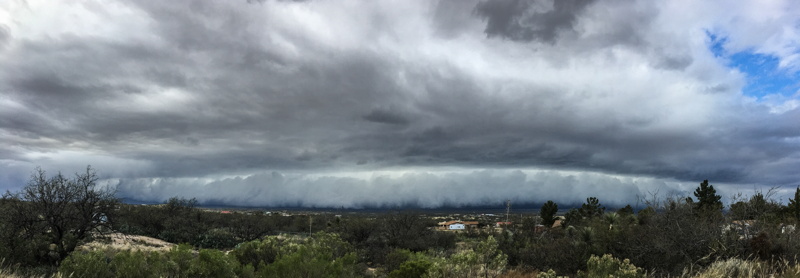Winter Storm;
Comet 45P/Honda-Mrkos-Pajdusakova, Star RW Tauri
Posted: 27 December 2016
Saturday, 24 December 2016, dawned clear but the forecast for that night was for cloudy skies and possible snow. I had hoped to observe the eclipse of the variable binary eclipsing star RW Tauri that night (mid-eclipse at 2313 MST). The winter storm had a dramatic approach to Oracle:

Click or tap on image for larger version
A little later had some sprinkles of rain that quickly turned to sleet, followed by snow:

I posted a short (13 seconds) time-lapse video covering 2 hours and 18 minutes of the approaching storm and then the snow.
Obviously I missed out on the RW Tauri eclipse. Will try again on Tuesday, 27 December.
Received nearly 2" of snow here from this storm. Here's the view towards the observatory on Christmas morning:



In anticipation of a clear night I went to the observatory Sunday afternoon, 25 December, to remove the snow from the dome. Unfortunately, the sky was still partly cloudy and with the temperature approaching 32°F and the humidity at 72% I skipped going to the observatory Sunday night. Monday, 26 December, was mostly clear during the day.
|
Open: Monday, 26 December 2016, 1803 MST Temperature: 55°F |
Session: 1055 Conditions: Partly cloudy, breezy |
Equipment Used:
12" f/8 LX600 w/StarLock
Wired AutoStar II handset
2" 24mm UWA eyepiece
Camera:
D7200 DSLR
1808 MST: LX600 ON, StarLock OFF, High Precision OFF.
1809 MST: quick look at Venus, 102X.
Slewed to the star Altair and SYNCed the AutoStar.
1812 MST: Wi-Fi ON. Used SkySafari 5 Pro on the iPhone to GOTO Comet 45P/Honda-Mrkos-Pajdusakova. The comet was very low in the southwestern sky. 1813 MST: the comet coma was faintly visible using 102X close to a star. 1817 MST: tried to locate the comet in the sky using the 12x50 binoculars but the twilight sky was still too bright.
Began preparing to try to image the comet with the 12" telescope. Mounted the D7200 DSLR at prime focus + focal reducer. Focused using the star Altair and locked the primary mirror. Then slewed back to Comet 45P.
1832 MST: did a test exposure, 1 minute, ISO 1600. The comet coma was visible. 1836 MST: StarLock ON. Surprisingly the StarLock succeeded in locating a guide star and began reliable tracking even though the telescope was pointed very low in the sky. Did several exposures of various durations and ISO settings. This 2 minute, ISO 3200, StarLock autoguided, image taken at 1840 MST was the best one. The image has been cropped. The comet tail extends almost all the way to the left side.

1845 MST: seeing was not very good and with the comet low in the still twilight sky, I ended comet imaging. Wi-Fi OFF.
1847 MST: located Comet 45P with the 12x50 binoculars, very low and getting into a tree. Only the comet coma was visible in the binoculars and it was very faint.
Slewed to and SYNCed on the star Aldebaran. Tweaked the focus. Did some test exposures of the eclipsing varible star RW Tauri. I wanted to determine that I could image the star field and ID the stars as depicted on a chart in the Sky & Telescope article in the January 2017 issue, edited by me to show the field-of-view with a 50mm eyepiece:

This is a 1 minute, ISO 1600, prime focus + focal reducer, StarLock autoguided, image showing RW Tauri with stars that were easily identifiable in the chart (using the same orientation):

1907 MST: ended imaging. StarLock OFF. The next mid-eclipse of RW Tauri occurs Tuesday evening, 27 December, 1741 MST. Weather permitting I hope to observe the end of the eclipse, although the forecast is not good.
Removed the camera from the telescope. Viewed RW Tauri, 102X. Clouds were now increasing and seeing was not good. Took a quick look at M1 (Crab Nebula), 102X. Then began closing up for the night.
|
Close: Monday, 26 December 2016, 1926 MST Temperature: 45°F |
Session Length: 1h 23m Conditions: Partly cloudy |
Comments are welcome using Email. Twitter users can use the button below to tweet this report to your followers. Thanks.
Cassiopeia Observatory Home Page
Copyright ©2016 Michael L. Weasner / mweasner@me.com
URL = http://www.weasner.com/co/Reports/2016/12/27/index.html
